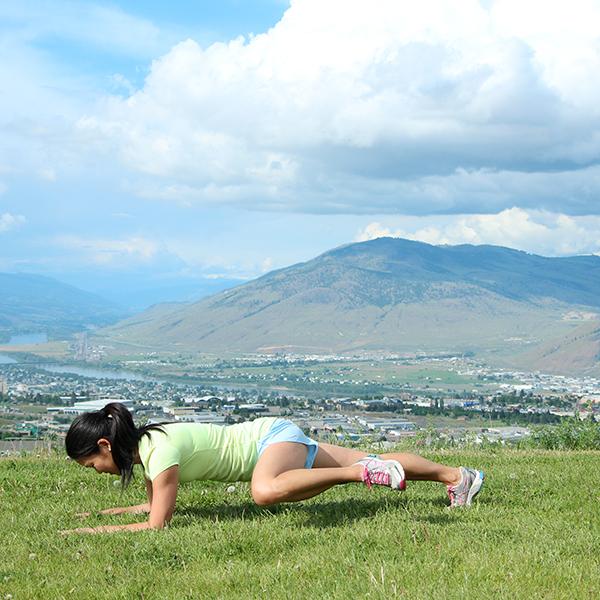Reduce knee pain with medication and exercise therapy
Combo therapy alleviates osteoarthritis knee pain enough to resume disease modifying exercise therapy.

How to Crush Your Outdoor Workout. ellecanada.com
By Rita Baron-Faust MPH, Rheumatology Network August 28, 2015
A combination of muscle strength training, aerobic training and pain medication has been shown to diminish knee pain enough to allow patients to resume regular exercise therapy.
Study shows a combined analgesic regimen with exercise therapy benefits patients with severe pain from knee osteoarthritis. Optimization of analgesics is a key to participating in exercise therapy. Exercise reduces pain and activity limitations in patients with knee osteoarthritis and severe pain.
Exercise therapy is one of the most effective interventions for knee osteoarthritis, but for many patients, the pain is so severe, that participating in an exercise therapy program is impossible.
Now, a new study of 49 patients finds that combining muscle strength training and some aerobic training with a step-up protocol of analgesics, alleviates enough knee pain to encourage patients to follow a regular exercise therapy regime. The study appears in the August 3 online issue of Arthritis Care & Research.
The researchers, led by Marike van der Leeden, PhD, a physical therapist at the Amsterdam Rehabilitation Research Center in Reade, call the newly developed intervention protocol “a significant innovation” that provides assistance in clinical reasoning of rheumatologists and PTs in the complex treatment of patients with severe knee pain.”
The study included 49 participants (42 were women) with a median age of 64 and pain scores of 7 or above on the Numeric Rating Scale. After a six week standardized regimen of analgesic medications, such as acetaminophen, NSAIDs, opioids and IA injection, the patients were enrolled in a 12-week exercise therapy program. The program consisted of six weeks of twice-weekly sessions targeting muscle strength (low intensity exercises).
During the second phase, exercise intensity increased with the addition of aerobic training, such as a treadmill and cross-trainer. Statistically significant improvements were found during the first six weeks with further improvements in final weeks of the trial. In total, 78% (n=36) of patients participated in 80% of the exercise therapy program. Improvements of 30% (p<0.001) from baseline for pain and 17% (p<0.001) from baseline for activity limitations were found after 18 weeks.
Patients used one or more pain medications – including acetaminophen (95.5%), NSAIDs such as ibuprofen or naproxen (40.9%), weak opioids like tramadol or codeine (34.1%) – and 2 patients had steroid injections in the knee joint. Doses were increased as needed by physicians with the goal of decreasing pain scores to at or below 5 on the NRS before the exercise program began. This was achieved in only 36% of patients.
Patients who could not participate in exercise therapy according to the protocol had significantly more severe radiological symptoms of osteoarthritis and had insufficient pain reduction at the 6 week mark. The study was limited by lack of a control group and the results need to be confirmed in a randomized controlled trial, the researchers wrote. In a review article published in the same issue of Arthritis Care & Research, Marcas Bamman, PhD, of the University of Alabama, and colleagues, support the adoption of proposed treatment guidelines for osteoarthritis and more randomized, controlled trials.
Treatment guidelines have been proposed by the American College of Rheumatology. “We fully support this recommendation but also recognize that it falls short of a well-defined exercise prescription because data from randomized, controlled trials comparing doses are sorely lacking,” they write. “Rigorous, large-scale trials are needed to provide the evidence base that should incentivize both clinicians and patients to adhere to prescribed exercise regimens.
“We suggest that this research should aim to:
- optimize both dose-response effectiveness and adherence;
- identify genetic and phenotypic determinants of responsiveness; and,
- better understand the interactive effects (e.g., synergism, antagonism) between exercise and both common and novel drug/device treatments.
“In our view, the high rates of inactivity among persons with osteoarthritis are troubling, and should fuel a robust, multi-tiered research effort with aims of optimizing exercise prescription to improve adherence and effectiveness in osteoarthritis.”
| Why is Exercise Prescription Important? |
- Exercise can manage symptoms of osteoarthritis such as pain reduction and reduced fatigue
- It could slow the loss of tissue and joint function
- Sedentary time confers an alarmingly elevated risk of multiple morbidities (diabetes, cardiovascular events, CV mortality and all-cause mortality.
Source Rheumatology Network
| References |
Optimization of Analgesics for Greater Exercise Therapy Participation Among Patients With Knee Osteoarthritis and Severe Pain: A Feasibility Study, van Tunen JA, van der Leeden M, Bos WH, Cheung J, van der Esch M, Gerritsen M, Peter WF, Roorda LD, Tijhuis GJ, Voorneman RE, Lems WF, Dekker J. Arthritis Care Res (Hoboken). 2016 Mar;68(3):332-40. doi: 10.1002/acr.22682. Full text
Exercise Medicine for Osteoarthritis: Research Strategies to Maximize Effectiveness, Bamman MM, Wick TM, Carmona-Moran CA, Bridges SL Jr. Arthritis Care Res (Hoboken). 2016 Mar;68(3):288-91. doi: 10.1002/acr.22680. Full text
2019 American College of Rheumatology/Arthritis Foundation Guideline for the Management of Osteoarthritis of the Hand, Hip, and Knee, Kolasinski SL, Neogi T, Hochberg MC, Oatis C, Guyatt G, Block J, Callahan L, Copenhaver C, Dodge C, Felson D, Gellar K, Harvey WF, Hawker G, Herzig E, Kwoh CK, Nelson AE, Samuels J, Scanzello C, White D, Wise B, Altman RD, DiRenzo D, Fontanarosa J, Giradi G, Ishimori M, Misra D, Shah AA, Shmagel AK, Thoma LM, Turgunbaev M, Turner AS, Reston J. Arthritis Care Res (Hoboken). 2020 Feb;72(2):149-162. doi: 10.1002/acr.24131. Epub 2020 Jan 6. Full text, PDF. Erratum in: Arthritis Care Res (Hoboken). 11 May 2021.
Also see
Good Reasons Not to Avoid Exercising a “Bad Knee” Rheumatology Network
Optimized analgesia, exercise cut pain in severe knee OA Rheumatology News Digital Network
Education Tools Lead to Improved Knee Osteoarthritis Management HCP Live
